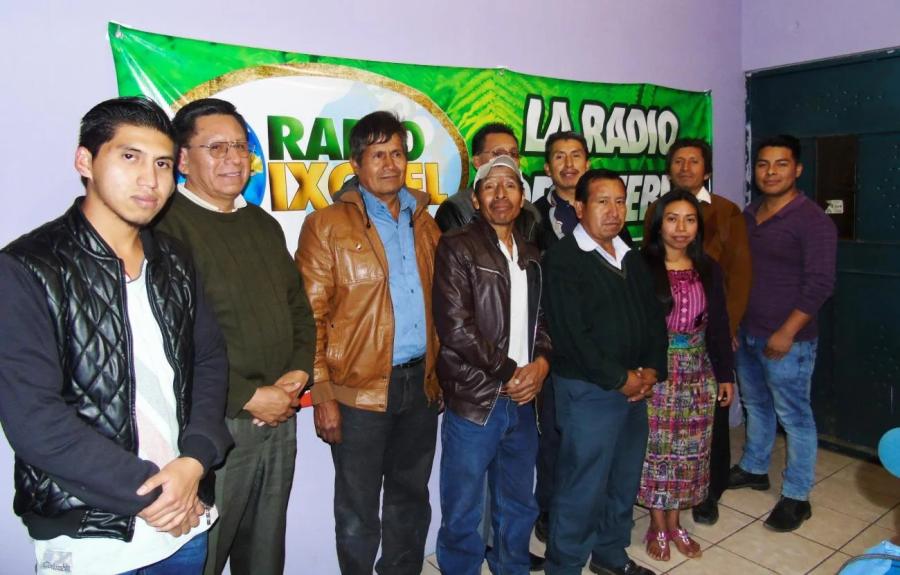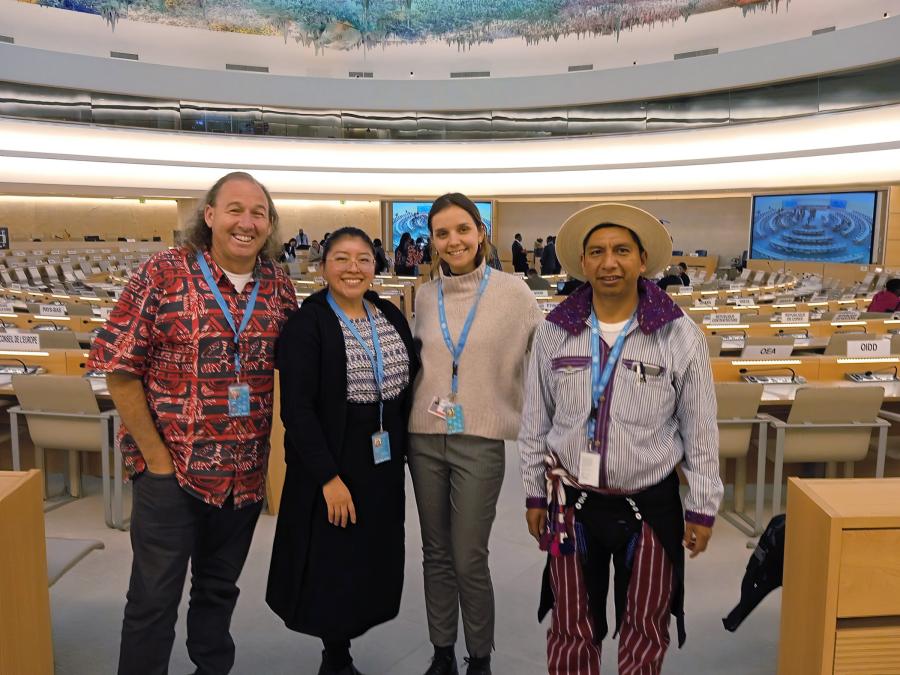It is generally known that until very recently Guatemalan Indians have not been active participants in the extensive revolutionary activity of that country, despite revolutionist claims and desires to the contrary.
Their involvement, for example, in the revolutionary government of 1944-54 was minor. The complete failure of the Patzizia Indian revolt of 1945 alone would suggest this, but there is other evidence. Leftist participants in that government now admit that the revolution was primarily by and for Ladinos, especially middle class Ladinos from Guatemala City. There is little evidence of an important indigenist movement associated with the revolutionary government.
Likewise, the guerrilla phase of the Guatemalan revolution during the 1960s and early 1970s was largely Ladino, the dominant ideology being Marxist. These revolutionaries developed a growing awareness of the need to include Indians in the movement, and in the late 1960s they spoke proudly of their Kekchi leader Pascual who taught the peasant Indians of Panzos and other places.
Eventually the guerrillas concluded that the revolution was being taught largely on behalf of Indians and that their joining the movement would be decisive for the cause.
The focus of guerrilla activity shifted to the Indian area of the Guatemalan highlands during the second half of the 1970s. Indians became involved in significant numbers. Before 1980 most Indian participation involved Indians who had worked as wage-laborers, from the northern zones of Huehuetenango, Quiche, and Verapaz: i.e., the Ixil, Uspantec, Kanjobal, Kekchi, and Mam Indians. Prehispanically, these groups of Indians were marginal to the more complexly-organized Quichean Indians of the southern and central highland zones, and they had not fared well in either colonial or recent political and economic developments.
The Quichean Indians of the heartland - the central and southern highland zones remained much more resistant to revolutionary activity in the late 1970s. Compared with their Indian brothers and sisters to the north they were economically better off and retained a more integrated native culture.
My studies of central Guatemalan Indians suggest that they tend to respond more favorably to expanded commercial opportunities than to socialist or revolutionary doctrines.
This may be seen through a simple class analysis of the Quichean Indians.
In all Central Highland townships, there exists a substantial Town Indian "Bourgeoisie." It is politically conservative, and holds middle class values. It tends to support military governments, sees guerrillas as bandits and as a threat to its interest.
In the rural zones resides the majority of the Indians, socially organized as a huge "peasantry." Peasants sell goods and work as wage-laborers while at the same time continue to be traditional cultivators and artisans. But whether traditional or transformed, they remain Indian - the traditionalists fanatically so. Wage-earning peasants, especially reformed Catholics, are highly religious; they see politics in theological terms. Peasants who produce for markets are more secular, often join Protestant churches; politically, they are more conservative, and frequently form alliances with the town bourgeoisie. The traditional peasants are Christopagans, holding to fascinating syncretic forms of colonial Catholicism and ancient Quichean culture; they generally lack political views wider than the local community.
In summary, the Guatemalan revolution has involved Indians slowly, and even then, only specific classes. During the past two to three years, however, the gates have opened wide. By the thousands even the Quichean Indians of the central area have stepped into the revolutionary fray. They have become active participants in the revolution as guerrilla soldiers, supporters of guerrillas, guerrilla leaders, spies, ideologists, etc. I have been surprised at the rapidity that Quiches, with whom I have worked for many years, converted from resisters to supporters of the guerrilla cause. The case presented below should help explain this change for both the central area and Guatemala as a whole.
The Indians Become Guerrillas: A Quiché Case
Santa Cruz del Quiche produced no authentic guerrillas before 1980. This does not mean that there were no sympathizers, peasant organizations, or even some contacts with guerrillas.
In September of 1980 a terrorist act occurred in Santa Cruz that revolutionized the Indians of Santa Cruz. On the 23rd of September, 1980, Santa Cruz' first Indian alcalde after centuries of Ladino rule was assassinated while riding home on his bicycle. His name was Abelino Zapeta y Zapeta. He was an acculturated Indian who lived in a hamlet a few kilometers from town, practised carpentry, and was deeply committed to the Catholic Action movement of the community.
I interviewed Alcalde Zapeta the morning of his assassination. He related an incident of great interest to me, telling of some Indians in one of his hamlets, La Estancia, who had become guerrillas. According to him, men from that hamlet had been harassed by the Army. Some were even killed. They consequently took up arms to defend themselves. Though Catholics, he said, they became guerrillas and would fire on the Army as it passed alongside the hamlet on maneuvers. This was the first reliable testimony I had received that there were guerrillas in Santa Cruz.
By 1980 La Estancia was a large community, numbering about 4,000 persons, all Indians. It was heavily agricultural, approximately 63% of the families subsisting primarily from the cultivation of traditional highland crops. Weaving was an important- secondary means of subsistence; some 25% of the families lived from the sale of weavings. Another 10% of the families made a living as travelling merchants, and another few (perhaps 2% of the families) owned trucks and pickups and made money through transportation.
Few of the La Estancia Indians worked on Pacific Coastal plantations. Such work was unnecessary because, through the use of fertilizers, cooperatives (La Estancia had five), and other progressive means the Indians of La Estancia were relatively wealthy. Most of the families earned from $1,000 to $3,000 per year. Thus, while the hamlet was overwhelmingly peasant, the vast majority owned lands and lived comfortably through income earned from agriculture and/or crafts.
The peasant Indians of La Estancia were overwhelmingly involved in the Catholic Action movement. At least 80% of the families were active - almost all agriculturalists and weavers. The merchants were comparatively secular in their beliefs. There were only a handful of traditionalists in the community and only a single family of Adventists.
As might be expected, the Christian Democratic party received a wide majority of votes from the Indians of La Estancia, especially in national elections; the two conservative parties polled only about 25% of the votes. The religious and political unity of most La Estancia Indians gave the community a strong collective spirit.
The collective spirit of the community is seen even more clearly in the strength of the Peasant Organization, CUC (Committee for Peasant Unity). CUC came to La Estancia in 1974. In 1980 almost everyone except the merchants had joined. CUC appears to have gradually replaced the Catholic Action organization as the collective secular structure of La Estancia, all its leaders came directly out of the Church leadership. Though originally set up under the direction of outside peasant leaders, it later became locally autonomous. While not directly militarized, it functioned to provide vigilance against outside interference, to gather intelligence information, to coordinate activities with peasants from other Santa Cruz hamlets and the region, and to promote political education - especially to awaken the Indians to their subordinate position as peasants in Guatemalan society. In La Estancia CUC was not seen as Marxist or revolutionary, but as a local organization necessary to protect the vast majority of inhabitants against an increasingly hostile government.
Incredible as it may seem, given the conditions outlined above, before the end of 1980 the entire community of La Estancia, some 4,000 individuals, except for a few families in an isolated mountainous zone, had disappeared. A band of about 40 young men and women had joined the EGP (Guerilla Army of the Poor) guerrillas. The rest of the people had become refugees, scattered throughout Guatemala and neighboring countries; all had become guerrilla sympathizers. The situation was actually much more radical than Alcalde Zapeta had understood. How did this incredible transformation take place?
One big step, as noted before, was the assassination of Indian leaders like Alcalde Zapeta. Zapeta's family had seen the Ladino assassins, who were picked up by a speeding Army jeep shortly after the assassination. A few months before, one of the cooperative leaders from La Estancia had also been assassinated. The murder was highly symbolic, for the young man was killed in front of the Utatlan ruins, where the ancient Quiche capital had been. On that occasion too, the assassins were seen by Indian witnesses; they were once again Ladinos affiliated with the Army. The killing of Alcalde Zapeta and the cooperative leader, neither of whom were revolutionaries, greatly alarmed and angered the Indians of La Estancia. Little did they know that the terror directed against them by their own government was just beginning.
Three days after the assassination of Alcalde Zapeta some thirty to fifty armed men arrived in jeeps at La Estancia early in the morning. In a house to house search, using lists, they tracked down the Catholic Action, CUC, and cooperative leaders of the hamlet. By the time they completed their assignment, fifteen people including several adolescents, had been massacred. One CUC-Catholic Action leader was crucified between two trees, his side pierced with a knife. According to witnesses from La Estancia these paramilitary assassins were Ladinos from the Oriente.
The terrified La Estancia Indians redoubled their vigilant guard. The men guarded by night, the children by day. At that time, many of the men began to sleep together, occupying a different house each night. They still had no modern weapons, and armed themselves with slings, machetes, and stones.
In November, Guatemalan soldiers arrived in force, this time by a different road (though they sent a jeep as a decoy along the same route the paramilitary assassins had come). Starting from the southern end of the hamlet, the soldiers systematically began searching homes for arms. According to witnesses, one of the Lieutenants was black, and many of the soldiers were Indians. Entire families, unarmed, were killed in cold blood, riddled with machine gun bullets as they cowered or slept in their beds. In all, fifty people were killed, including many women and children: they even killed a seventy-year-old man.
The dazed La Estancia Indians buried their dead in large holes dug in the ground - to have brought coffins from the town center for proper burial would have been seen as subversive. It was not even possible to officially report the killings.
The women of the hamlet collectively beat to death a suspected informer in the marketplace of a nearby town, and a band of 30-40 youth left for the north to join the guerrillas. Then, as the rain poured down, the remaining inhabitants of La Estancia broke into families and silently left their homes. A community that had existed for a thousand years disappeared!
It is all too clear that the Guatemalan Army and its paramilitary forces created the revolutionary situation that Alcalde Zapeta so understated to me that day in 1980. One might think that La Estancia was an unlikely place for such political mobilization, and perhaps it was. But what occurred there was typical of what has happened to other parts of Guatemala and the world.
What will constitute acceptable solutions for peoples throughout the world made refugees through similar violence perpetrated by governments reportedly representing them?
Article copyright Cultural Survival, Inc.



